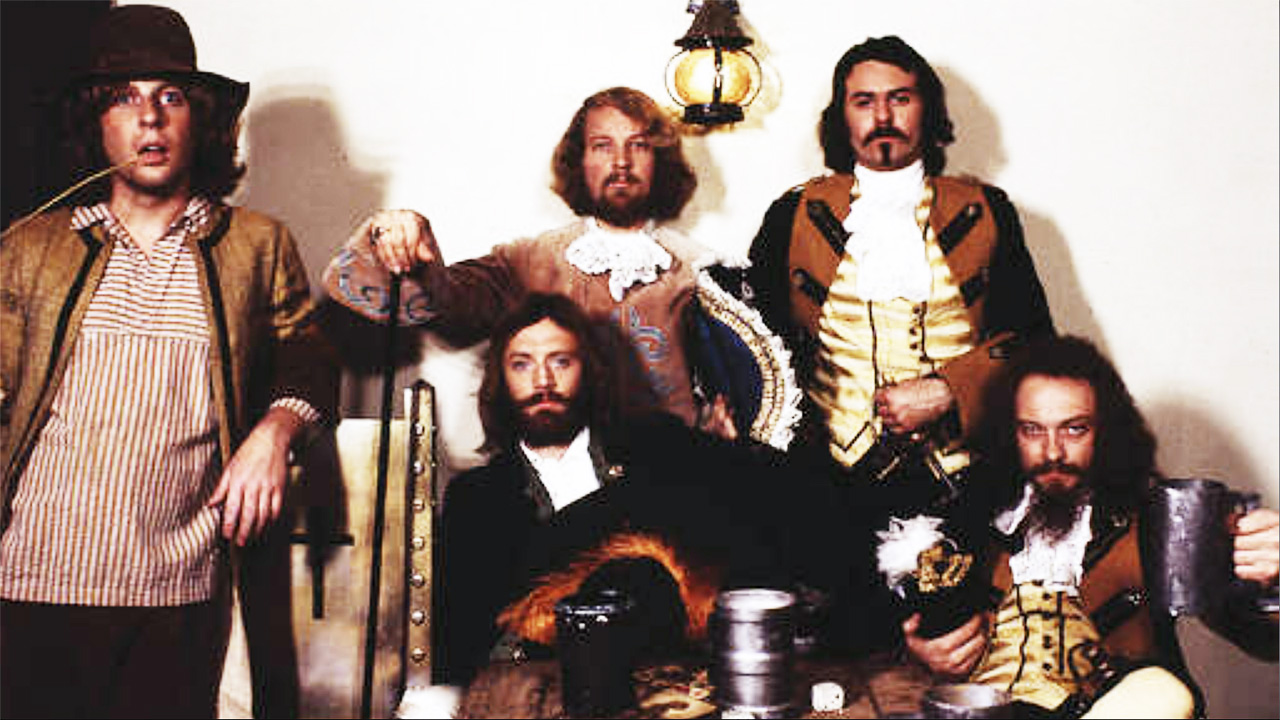“I never write about people I know. I’ve always been against the idea of betraying any kind of confidence”: Are the touching tales of Jethro Tull’s Minstrel In The Gallery really just fiction?
Ian Anderson reflects on giving Roy Harper his movie break, aggressively defending Dee Palmer from paparazzi intrusion, losing bassist Jeffrey Hammond, planning to quit touring – and the quiet couple of weeks he spent recording Tull’s masterful 1975 album

In 1975 Jethro Tull decamped to the French Riviera to record eighth studio album Minstrel In The Gallery. As the record celebrates its half-century, Ian Anderson recalls its creation between breaks in a lengthy touring cycle that would eventually lead to the departure of bassist Jeffrey Hammond – after having led Anderson himself to consider getting off the road for good.
In spring 1975, had you been in the vicinity of Radio Monte Carlo’s premises in Monaco, you might have seen Ian Anderson dismount his Ossa trials motorcycle and go inside. It was there, in a sprawling live room big enough to facilitate games of badminton between takes, that Jethro Tull recorded their eighth studio album, Minstrel In The Gallery, between May 15 and June 7.
While Renaissance made Scheherazade And Other Stories at London’s Abbey Road and Mike Oldfield tracked Ommadawn in rural Herefordshire, it was the first time Tull had recorded an LP outside the UK, and they’d shipped the Maison Rouge Mobile Studio out to Monaco along with Anderson’s bike. Now all he, guitarist Martin Barre, pianist John Evan, bassist Jeffrey Hammond and drummer Barriemore Barlow had to do was resist holiday resort temptations and knuckle down.
“In 1973, we’d tried to record an album [1974’s War Child] in the relatively famous residential studio Château d’Hérouville, just outside Paris,” says Anderson. “It was awful. That notion of removing yourself from everyday life and concentrating on the music often just meant people lounging by the pool wasting time and money. But for me, personally, Monte Carlo wasn’t much of a distraction. In fact it was the antithesis of the kind of place where I’d have said, ‘Ooh, let’s go there for a holiday!’ Then, as now, it was full of affluence and snobbery.”
Anderson was there under slight duress. Both Jethro Tull’s accountant and their manager Terry Ellis had recommended recording there to gain non-resident tax advantages – but this, says the band leader, made him feel uncomfortable. “And it turned out that there were no financial benefits anyway,” he adds. “I paid all of my UK taxes for that year, just as I have done all of my life. But we didn’t want to go back to Château d’Hérouville and Monaco was reasonably accessible. In the end we were pretty well-organised. I might have jokingly referred to my bandmates ‘goofing off’ because, unlike me, they had time to go for a drive down the coast. But the truth was I had a lot to do on my own anyway. It was a very productive time.”
Now at its 50th anniversary, Minstrel In The Gallery was a near- masterpiece. Melding Elizabethan classical elements with nuanced and complex folk music, it also saw Martin Lancelot Barre’s brawny electric guitar put the rock into baroque on the LP’s fine title track and wondrous, near-17-minute epic Baker St Muse. “We were trying to extend the boundaries – always pushing forward,” the guitarist told Louder in 2014. “We were also quite isolated from other influences, and that made us unique.”
Songwriting-wise, one might consider there are two Ian Andersons on Minstrel – there’s the starry-eyed balladeer of Requiem and Grace, then there’s the outsider figure and people-watcher who, on Baker St Muse, sketches the seedy underbelly of the northwest London locale he was living in when he wrote it. Vomiting drunks, Rubenesque prostitutes, furtive back-lane fumblings and a destitute old woman all figure; the song inhabits an earthy, almost Hogarthian world.
Sign up below to get the latest from Prog, plus exclusive special offers, direct to your inbox!
Minstrel was prog rock part-adjacent to Anderson’s famed codpiece and raincoat, then, not just the stuff of amour-gone-wrong or pastoral beauty; although there was plenty of that, too. Better yet, the intricacies of the musical arrangements kept pace with its extraordinary lyrical invention.
“Anything to do with Jethro Tull and Ian Anderson was automatically of a very high standard,” said Minstrel violinist and long-term collaborator Patrick Halling in 2012. And in February 1975, after the band had played five sold- out nights at the LA Forum, the world at large was hip to their ascendancy.
“Are they the world’s biggest band?” Melody Maker wondered. Difficult to imagine now, perhaps – but with Jethro Tull’s US concerts making pioneering use of giant video screens they playfully dubbed ‘Tullavision,’ their primacy, or near-primacy, had become very real.
The rather personal backdrop to Minstrel In The Gallery was Anderson’s divorce from first wife Jennie Franks the previous year. When she was a photography student, she’d co-written lyrics for the title track of 1971’s Aqualung. The imagery she’d used was reputedly inspired by photographs of homeless men she’d shot on a project with the Salvation Army in Victoria, London.
I was married to Jennie for a few years… There were no big fights or arguments. It just wasn’t going to work
Anderson’s break-up with Franks isn’t the easiest subject to broach when his wife of the last 48-odd years, Shona Learoyd, is sitting opposite him. But he explains, “I was married to Jennie for a few years before we very amicably split up. There were no big fights or arguments. It just wasn’t going to work.”
The divorce seems to be implicated in Minstrel’s gorgeous song of farewell, Requiem. Sentiment-wise, it’s akin to Whitesnake’s Here I Go Again, but there the similarity ends; Requiem is a more refined, tender and poetic thing. ‘Saw her face in the tear-drop black cab window / Fading in the traffic; watched her go’, sings Anderson wistfully. Was it about Franks?
“No,” he says. “I never really write about people I know. The characters in my songs are stereotypes, people I don’t know, or completely imaginary. I’ve always been against the idea of betraying any kind of confidence.”
And what of Requiem’s similarly classy companion piece One White Duck/010 = Nothing At All, which is surely one of Anderson’s finest ballads? Some sources claim that it, too, was about his divorce. “No, not all,” he says calmly. “That’s wrong. Clearly the song is about the end of a relationship, but it wasn’t about the end of my then-relationship. The only personal aspect of it had to do with a childhood memory of mine. We had white plaster ducks on our living-room wall, and I can still see my mother sitting in a chair watching television with the ducks flying behind her. In the song those three ducks became one.”
The notion of not betraying confidences leads him to cite another instance: he says that, in 1972, he was approached to star alongside actress Carol White (best known for the famed 1966 BBC play Cathy Come Home) in the British drama film Made. “Basically, Carol White’s character enters into a relationship with a singer-songwriter, who then uses that relationship to write lyrics, which betray her intimacy,” Anderson says.
The film was that it involved getting naked in the bath with Carol White. I thought, ‘I’m not getting my kit off for the camera!’
“I turned it down saying, ‘Number one, I’m not an actor; and number two, it doesn’t suit my ethics.’ They said, ‘OK, that’s a shame – anyone else you can think of who might be suitable?’ I thought for about 10 seconds and said, ‘Yeah. Roy Harper!’”
Harper, the famed singer-songwriter behind such landmark prog folk albums as 1971’s Stormcock, was indeed cast in Made. And, for Anderson at least, what happened next was predictable. “Roy ends up having an affair with his co-star, of course! I remember him bringing Carol to my house, arriving late at night and asking if he could come in for a drink. After about half an hour of merriment I said, ‘Look, Roy. It’s getting late and I’m up early tomorrow – can we call it a night?’ He said, ‘No problem, Ian. I’ve just remembered Carol’s still outside in the Rolls-Royce!’
“Another reason I didn’t want to do the film was that it involved getting naked in the bath with Carol,” he adds. “I thought, ‘I’m not getting my kit off for the camera!’”
When Prog asks about Summerday Sands – a bonus track on later editions of Minstrel, and a brilliant story-song ornamented by Hammond’s exploratory bass and Barre’s Richard Thompson-like guitar fills – Anderson maintains that its lyric, too, were just a product of his imagination. Was it, though? It seems too perfect an evocation of a chance romantic encounter to be fiction, too rich in tell-tale clues (‘I gave her my raincoat...’). True, there’s no mention of the song’s protagonist seducing anyone via Bach’s flute sonata in E minor, but still...
“It’s just a nostalgic song, imagining some romantic liaison at some remote beach somewhere,” says Anderson. “It was recorded in Surrey, if I remember correctly, and Dee Palmer put some lovely strings on it at some point. It’s the kind of thing you could imagine Roy Harper doing, actually. Roy’s songwriting and guitar playing were quite an influence on me from about 1971 onwards.”
I said, ‘Look into my eyes while I ask you a question: Don’t you think I’d be the ugliest fucking woman you ever met in your life?!’
Remarkably, given their complexity and intricacy, several Minstrel tracks were first takes. That’s why you can hear Anderson counting in songs, and sometimes announcing their titles. Tull had done their homework, having rehearsed and finessed the material in the annexe of the Montreux Palace Hotel. “That was thanks to dear old Claude Nobs of Smoke On The Water fame,” says Anderson. “He’d been our promoter in Switzerland since 1969 and had pulled some strings.”
Anderson had completed the songwriting for Minstrel while renting a villa in “LA somewhere – one of the canyons,” ahead of an epic US tour. String arranger extraordinaire Dee Palmer, who’d soon become Tull’s full-time keyboardist, had visited Anderson to fine-tune arrangements. Although she left in 1980, the frontman still speaks of her with fondness and admiration.
“This was long before music notation software programs like Sibelius,” he explains. “It was fascinating for me as a non-academic musician to see how Dee worked so brilliantly with pencil and manuscript paper.”
Anderson wanders off-piste; but the story he relates demonstrates his loyalty to Palmer, who came out as transgender in 1998, and without whom Aqualung and Thick As A Brick would not be quite so special. “I’d come home from tour, a few months after that Italian fan club convention in 2001, and my wife told me the News Of The World were camped out near our farm, and that one of the journalists had come to our door demanding to speak to me. Shona had been very upset by the intrusion, so I immediately got in the car and went to confront them.”
The reporter had apparently had a tip-off that Anderson was transgender, had been wearing women’s clothing for years, and was changing his name to Dee. She was quite insistent and badgered him, repeatedly asking if he denied it. “I said, ‘I will not deny it, because that would sound disapproving, and I’m not disapproving.’”
Competing with Elton John to see who could do the most shows at Madison Square Garden never interested me
Finally, having had enough of the intrusion, he snapped. “I said, ‘Come closer. No, closer... Right, look into my eyes while I ask you a question: Don’t you think I’d be the ugliest fucking woman you ever met in your life?!’ At which point she scurried back to her colleagues and they all drove off!”
He guffaws at this, then continues: “About two miles down the road, I suddenly remembered that we sometimes called Palmer ‘Dee P.’ So I rang her on the spur of the moment and explained what had happened. She laughed and said, ‘How fortuitous that you’ve called, Ian. I’ve been meaning to get something off my increasingly ample chest...’ Apparently Dee had felt that way for many years, and when her wife died, that was the trigger for her to become Dee Palmer. Fair play to her.”
If there’s ultimately only so much Ian Anderson can remember about the making of Minstrel In The Gallery, it’s unsurprising. It was half a century ago; two weeks of relative serenity in an otherwise hectic year rammed with January-December live shows. Jethro Tull undertook two lengthy tours of North America and a similarly gruelling trek across Europe in 1975. Anderson appreciated the ravenous appetite for Tull’s music, but the massive arenas where the ‘Tullavison’ screens had become something of a necessity didn’t float his boat.
“I’m a theatre guy,” he says. “Maximum capacity is about 2000, the audience seated comfortably. That suits my style as a musician and performer. Competing with Elton John to see who could do the most shows at Madison Square Garden never interested me in the slightest.
Jeffrey was known for his elaborate, zebra-stripe suit… after that final show he set fire to it behind the venue in order to cleanse himself
“Even in 1972, by the end of a particularly arduous leg of the Thick As A Brick US tour, I was close to telling my then-manager Terry Ellis, ‘No more concerts, full-stop,’” Anderson adds. “Instead I said, ‘No more arenas, please!’ But then I relented, of course. There was a lot of pressure to meet the demand.”
Little wonder, then, that after the further touring demands of 1975, he felt like a minstrel in the gallery himself; a court jester, subject to forces and demands beyond his control. Indeed, Minstrel’s cover art – a tweaked version of an 1838 oil painting by Joseph Nash depicting minstrels performing before a raucous crowd/menagerie at Haddon Hall, Derbyshire – said as much.
“I felt we were in the public domain, but cut off, like entertainers,” Anderson told Classic Rock in 2020. “You were of a different caste; you were travelling salesmen, carnival people. The audience found you seductive and interesting, but you didn’t belong with them.”
As so often with bands on tour, this odd bubble of isolation bred mischief. At a 1975 show in Portland, Oregon, Tull brought a fake zebra onstage, whereupon bassist Jeffrey Hammond was seen to ‘extract’ two white balls from its rear end and make like a circus performer. “I bet you never thought you’d see us juggling zebra shit,” quipped Anderson.
Perhaps it was the striped beast’s ordure, or maybe it was just exhaustion, but after the final date of that tour –at Purdue University in West Lafayette, Indiana on November 2 – Hammond quit the band and subsequently became a painter of landscapes.
“Jeffrey was known for his rather elaborate, zebra-stripe suit,” says Anderson, “and after that final show he set fire to it behind the venue in order to cleanse himself from his time in Jethro Tull. I thought he was just enjoying a theatrical moment and he’d come back to us after some proper rest. Sadly, he didn’t. None of us could persuade him to do so.”
But Tull were far from done, of course, and by November 19 they were back in Monte Carlo to work on 1976’s Too Old To Rock ’N’ Roll: Too Young To Die! on which John Glascock would play bass.
“Like I said,” says Anderson, “it was a very productive time.”
James McNair grew up in East Kilbride, Scotland, lived and worked in London for 30 years, and now resides in Whitley Bay, where life is less glamorous, but also cheaper and more breathable. He has written for Classic Rock, Prog, Mojo, Q, Planet Rock, The Independent, The Idler, The Times, and The Telegraph, among other outlets. His first foray into print was a review of Yum Yum Thai restaurant in Stoke Newington, and in many ways it’s been downhill ever since. His favourite Prog bands are Focus and Pavlov’s Dog and he only ever sits down to write atop a Persian rug gifted to him by a former ELP roadie.








